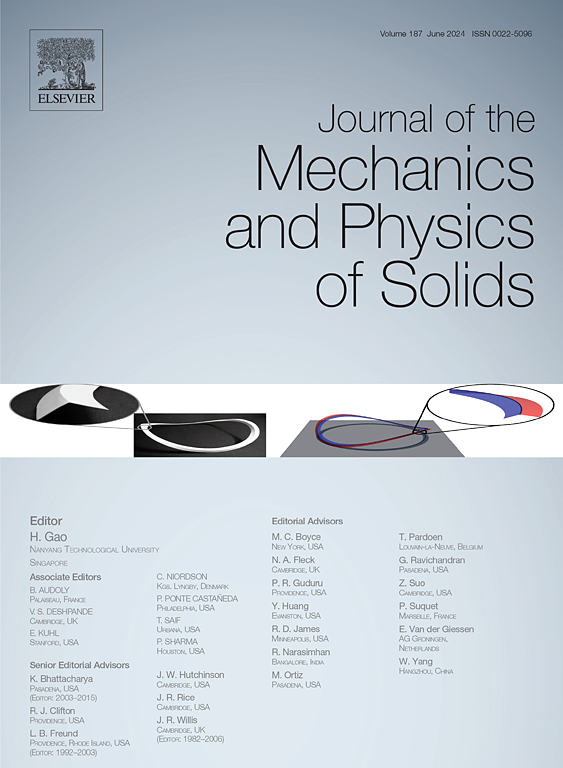Three-dimensional micromechanical expression for the average strain tensor of granular materials
IF 6
2区 工程技术
Q2 MATERIALS SCIENCE, MULTIDISCIPLINARY
引用次数: 0
Abstract
In investigations of the behaviour of granular materials, the conversion of discrete contact information, specifically the force and displacement data, into macroscopic quantities such as stress and strain is a fundamental approach. The expression for the average stress tensor, a well-established formulation, involves the summation over all interparticle contacts while considering both the contact force and geometric parameters such as the branch vector. However, for the three-dimensional case, a general micromechanical expression for the average strain tensor is still missing.
In this study, a three-dimensional micromechanical expression is derived for the average strain tensor of granular materials. The new expression for the strain tensor involves only particle positions and relative displacements between particles, and does not depend on the tessellation method applied to the space occupied by the particles and interparticle voids. To validate the accuracy of the strain tensor, displacement data of granular assemblies were generated through Discrete Element Method simulations, and the strains of granular assemblies calculated by the derived strain tensor were compared with those calculated from the macroscopic deformation of granular assemblies. The results demonstrate that the proposed strain tensor is consistent with the macroscopic strain tensor, either in triaxial compression or in simple shear tests. This research conclusively addresses the fundamental question for the three-dimensional micromechanical strain tensor of granular materials and contributes to the development of accurate micromechanics-based constitutive models for granular materials.
颗粒材料平均应变张量的三维微力学表达式
在粒状材料行为的研究中,将离散接触信息,特别是力和位移数据转换为宏观量,如应力和应变,是一种基本方法。平均应力张量的表达式是一个公认的公式,它包括所有质点间接触的总和,同时考虑接触力和分支矢量等几何参数。然而,对于三维情况,平均应变张量的一般微力学表达式仍然缺失。本文推导了颗粒状材料平均应变张量的三维微力学表达式。应变张量的新表达式只涉及粒子位置和粒子之间的相对位移,而不依赖于应用于粒子和粒子间空隙所占空间的镶嵌方法。为了验证应变张量的准确性,通过离散元法模拟生成颗粒组合的位移数据,并将导出的应变张量计算的颗粒组合应变与颗粒组合宏观变形计算的应变进行比较。结果表明,无论是在三轴压缩试验中,还是在单剪试验中,所提出的应变张量都与宏观应变张量一致。本研究最终解决了颗粒材料三维细观力学应变张量的基本问题,有助于建立基于细观力学的颗粒材料精确本构模型。
本文章由计算机程序翻译,如有差异,请以英文原文为准。
求助全文
约1分钟内获得全文
求助全文
来源期刊
CiteScore
9.80
自引率
9.40%
发文量
276
审稿时长
52 days
期刊介绍:
The aim of Journal of The Mechanics and Physics of Solids is to publish research of the highest quality and of lasting significance on the mechanics of solids. The scope is broad, from fundamental concepts in mechanics to the analysis of novel phenomena and applications. Solids are interpreted broadly to include both hard and soft materials as well as natural and synthetic structures. The approach can be theoretical, experimental or computational.This research activity sits within engineering science and the allied areas of applied mathematics, materials science, bio-mechanics, applied physics, and geophysics.
The Journal was founded in 1952 by Rodney Hill, who was its Editor-in-Chief until 1968. The topics of interest to the Journal evolve with developments in the subject but its basic ethos remains the same: to publish research of the highest quality relating to the mechanics of solids. Thus, emphasis is placed on the development of fundamental concepts of mechanics and novel applications of these concepts based on theoretical, experimental or computational approaches, drawing upon the various branches of engineering science and the allied areas within applied mathematics, materials science, structural engineering, applied physics, and geophysics.
The main purpose of the Journal is to foster scientific understanding of the processes of deformation and mechanical failure of all solid materials, both technological and natural, and the connections between these processes and their underlying physical mechanisms. In this sense, the content of the Journal should reflect the current state of the discipline in analysis, experimental observation, and numerical simulation. In the interest of achieving this goal, authors are encouraged to consider the significance of their contributions for the field of mechanics and the implications of their results, in addition to describing the details of their work.

 求助内容:
求助内容: 应助结果提醒方式:
应助结果提醒方式:


